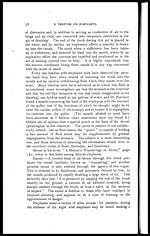Medicine - Veterinary > Veterinary diseases > Elephants and their diseases > Part II - Outlines of anatomy and physiology
(117) Page 77
Download files
Individual page:
Thumbnail gallery: Grid view | List view

THE CHEST AND ORGANS OF RESPIRATION. 77
the back of the mouth, and so through the wind-pipe to the lungs.
These passages are lined throughout with mucous membrane, in the
uppermost part of which are lodged the nerves concerned in the
sense of. smell. It may conveniently be divided into two parts,
namely, the muscular portion or trunk, and the osseous or bony.
The muscular portion or trunk is a most remarkable appendage,
but is not peculiar to the elephant, as the tapir has a somewhat
similar organ. It is composed of an intricate arrangement of
muscles which furnish it with great flexibility, contractility, and
power, so that its uses are manifold. The animal is enabled to snap
off boughs, pull down saplings, pluck up bunches of grass and
herbs—in fact, on his trunk depends his life, since both food and
drink are ingested through its aid. He can employ it to lift and
drag light weights. An elephant will not use his trunk either for
offence, defence, or work where there is any probability of this
extremely sensitive and essential organ sustaining any injury, and this
is exemplified by the way in which he curls up the organ after the
manner of a watch-spring, and raises his head when in the act of
charging, and not free and uplifted as often represented in many
pictures.
At the extremity of the trunk the anterior part is developed into
a finger-like structure, which is capable of being approximated to the
posterior wall. By means of this process he is able to pick up
articles of small size, but not to the extent that he has been popularly
credited with. Its contractility is shown by his power of shortening
and lengthening this organ and, as will be again referred to on some
future page, this contractility, by causing a shrivelling of the trunk,
often serves as a valuable indication of ill-health. Again; it is
through the muscular character of its walls that he is able to dilate
the canals and increase their capacity during the act of suction.
This muscular mechanism is supplied by the seventh pair of nerves
which are unusually developed in this animal and hence accounts for
its power, varied and complicated mobility. The skin covering the
trunk is soft and pliable, and that in the posterior region is puckered
into a series of transverse ridges, giving it a permanent roughness
which materially aids in the tenacity of its grip. It is also the
medium through which this organ is endowed with one of its most
important uses, for it is in the deeper layers of the skin that the
elements of the sense of touch are lodged. It is supplied by the
fifth pair of nerves which are also unusually developed in the elephant
and accounts for its exquisite sensibility.
The canals are two in number and lie nearer to the front of the
organ. They are of about the same calibre throughout, and are
lined by mucous membrane. They are capable of a certain amount
Set display mode to: Large image | Zoom image | Transcription
Images and transcriptions on this page, including medium image downloads, may be used under the Creative Commons Attribution 4.0 International Licence unless otherwise stated. ![]()
| India Papers > Medicine - Veterinary > Veterinary diseases > Elephants and their diseases > Outlines of anatomy and physiology > (117) Page 77 |
|---|
| Permanent URL | https://digital.nls.uk/75192377 |
|---|



![[Page 76]](https://deriv.nls.uk/dcn4/7519/75192376.4.jpg)
